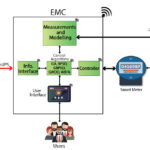Empowering Industrial Growth : Energy Monitoring in Manufacturing Sector
The manufacturing sector plays a pivotal role in the global economy, driving innovation, job creation, and economic growth. However, it is also a major consumer of energy, making it imperative for manufacturers to adopt sustainable practices that not only reduce environmental impact but also enhance operational efficiency and cost-effectiveness. Energy monitoring is a critical tool that empowers industrial growth by helping manufacturers make informed decisions about their energy consumption. In this article, we will explore the significance of energy monitoring in the manufacturing sector and how it can lead to a more sustainable and prosperous future.

1. Cost Reduction:
- Energy monitoring identifies areas of energy waste and inefficiency, allowing manufacturers to implement cost-effective measures to reduce energy consumption.
- By optimizing energy usage, companies can lower their energy bills, which can significantly impact their bottom line.
2. Enhanced Operational Efficiency:
- Real-time energy monitoring provides valuable insights into equipment performance and operational processes.
- Manufacturers can identify equipment that is operating suboptimally or nearing failure, enabling proactive maintenance and minimizing downtime.
3. Sustainability and Environmental Compliance:
- Energy monitoring helps manufacturers track their carbon footprint and energy-related emissions.
- By reducing energy consumption and emissions, companies can comply with environmental regulations and meet sustainability goals, which can enhance their reputation and competitiveness.
4. Predictive Maintenance:
Energy monitoring systems can predict equipment failures based on energy usage patterns and deviation.
This enables manufacturers to schedule maintenance activities before critical equipment breaks down, minimizing disruptions and production losses
5. Resource Allocation:
- Manufacturers can allocate resources more efficiently based on energy consumption data.
- For instance, they can schedule production during periods of lower energy costs or prioritize energy-efficient equipment.
6. Energy Procurement Strategies:
- By analyzing energy consumption patterns, manufacturers can develop energy procurement strategies that take advantage of favorable pricing and minimize exposure to volatile energy markets.
7. Continuous Improvement:
- Energy monitoring promotes a culture of continuous improvement by providing data for benchmarking and setting energy efficiency goals.
- Manufacturers can track their progress and adjust strategies as needed to achieve energy efficiency targets
8. Data-Driven Decision-Making:
- Energy monitoring systems generate valuable data that can inform decision-making at all levels of the organization, from facility managers to top executives.
- Data-driven insights can lead to smarter investments in energy-efficient technologies and processes.
9. Technological Advancements:
- The adoption of advanced technologies, such as IoT sensors and AI-driven analytics, in energy monitoring allows for even more granular and real-time insights.
- Manufacturers can leverage these technologies for predictive analytics and autonomous control of energy systems.
Benefits:
Regulatory Compliance: Energy monitoring aids in meeting regulatory requirements related to energy consumption and emissions. Staying compliant with these regulations avoids costly fines and legal issues, ensuring business continuity and reputation preservation.
Improved Equipment Longevity: By closely monitoring equipment performance and energy usage, manufacturers can extend the lifespan of their machinery. Regular maintenance and optimized energy consumption contribute to equipment durability, reducing the need for frequent replacements and capital expenditures.
Employee Engagement and Morale: Employees often take pride in working for companies that demonstrate a commitment to sustainability and efficiency. A culture of energy monitoring and conservation can boost employee morale, engagement, and productivity.
Competitive Advantage: Manufacturers that adopt energy monitoring gain a competitive edge in the market. Their ability to reduce costs, offer eco-friendly products, and meet customer demands for sustainability positions them favorably against competitors. It can also attract environmentally conscious customers and partners.
Drawbacks:
Complexity and Integration: Integrating energy monitoring systems into existing manufacturing processes can be complex. It may require significant changes to the infrastructure and production lines. Compatibility issues and integration challenges can lead to downtime during the implementation phase.
Data Overload: The vast amount of data generated by energy monitoring systems can overwhelm organizations, especially if they lack the necessary expertise in data analytics. Without proper data management and analysis, the information may not translate into meaningful insights or actions.
Resistance to Change: Resistance to new technologies and processes is common in many organizations. Employees may be resistant to the changes associated with energy monitoring, which can hinder the successful adoption and implementation of the system.
Maintenance and Calibration: Energy monitoring systems require regular maintenance and calibration to ensure accurate data. Neglecting maintenance can lead to inaccurate readings, potentially resulting in incorrect energy-saving decisions.
Lack of Standardization: The absence of standardized energy monitoring practices can lead to interoperability issues when different vendors’ systems are employed. This can complicate data management and integration.
Conclusion:
In conclusion, empowering industrial growth through energy monitoring in the manufacturing sector is a strategic imperative that holds the potential to drive sustainable development and enhance operational efficiency. While energy monitoring offers an array of significant benefits, including cost reduction, sustainability, and data-driven decision-making, it is not without its challenges.
Manufacturers must recognize the initial costs, complexity of implementation, and potential resistance to change as drawbacks that need to be carefully managed.
Call us on 8291366254
Mail us at:prashant.yadav@oneunit.in





